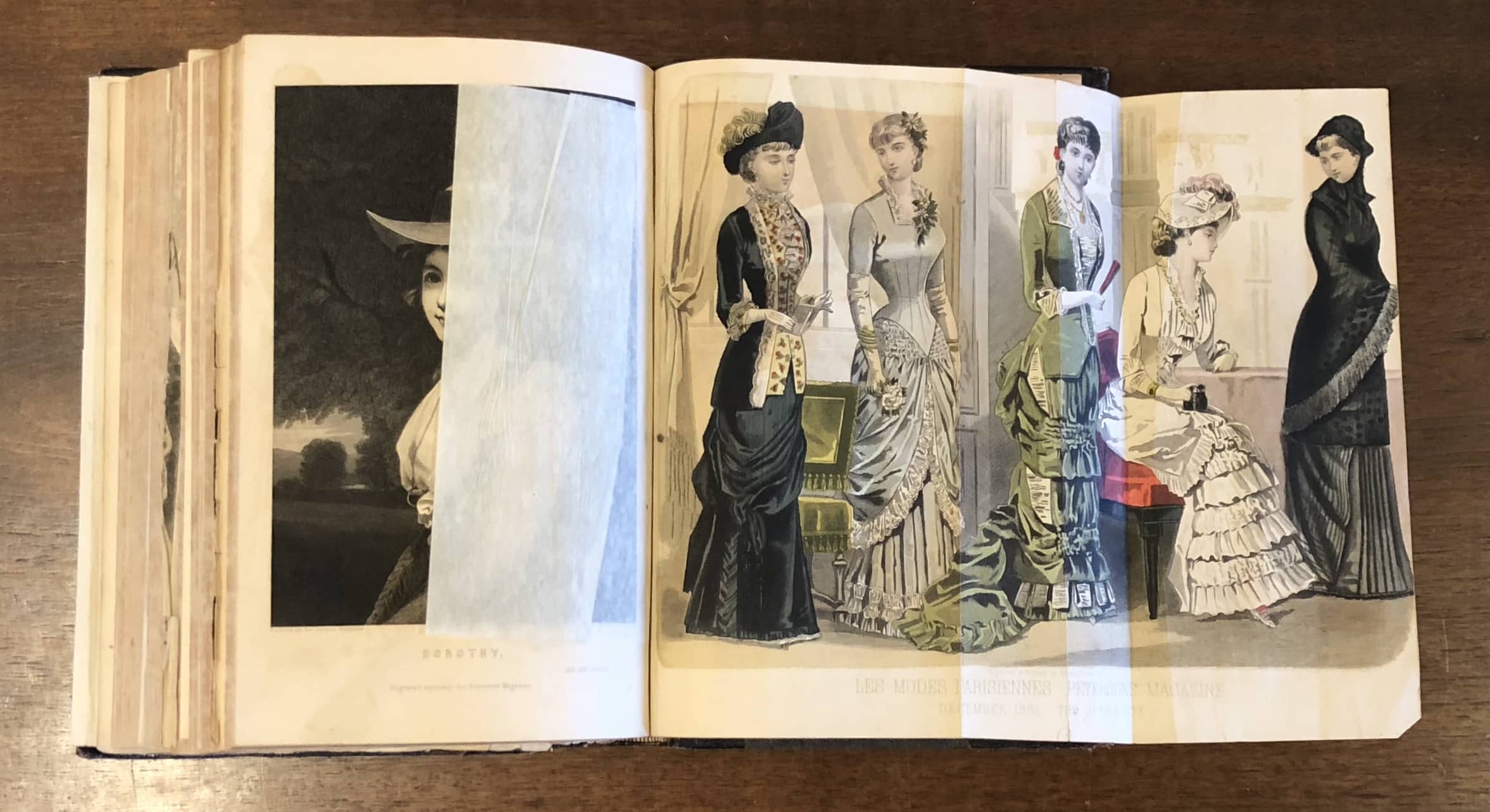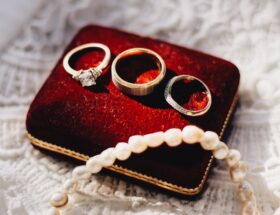By Pauline Weston Thomas for Fashion-Era.com
- Hand Coloured Engraving 1831 La Belle Assemblée
- Differences Between Costume Plates and Fashion Plates
- Fashion and Costume Print Prices
- Hand Coloured Engraving from 1831 La Belle Assemblée
Instead of collecting vintage or antique fashion clothes, many people choose to collect fashion-related paper ephemera.
This can include such diverse items as costume plates, fashion plates, ladies magazines, paper dressmaking patterns, paper fashion dolls, fashion drawings, fashion related antiquarian books and costume or fashion related photographs.
Some of these items can be antique, vintage or reproduction items related to the era, but all capturing aspects of fashion through illustrations made long ago.
I collect fashion plates of both authentic and reproduction types.
Just below is an example of a quality hand coloured 1831 fashion plate engraving I own and taken from the magazine La Belle Assemblée.
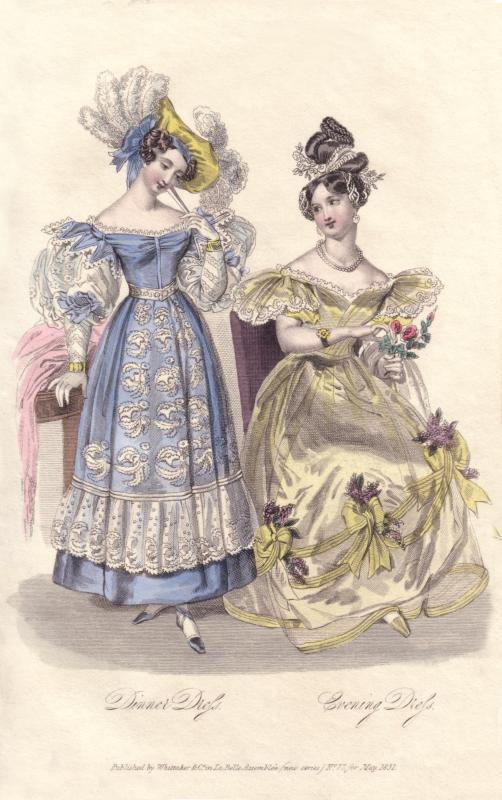
You can read more about the history of La Belle Assemblée and other fashion periodicals with fashion plates in my new section coming shortly.
Hand Coloured Engraving 1831 La Belle Assemblée
This hand-coloured engraving (click) is from a William IVth fashion periodical called La Belle Assemblée. It came complete with the text, a fashion description of fabrics and styles of the greatest detail for May 1831. Descriptive text is so often missing so this was a joy to read.
At 24cm by 15cm, La Belle Assemblée is often much smaller than people expect when they first buy original prints. That's because at about 9" tall it was intended to be held for reading.
However, the smallness means the engravings have a delicacy and daintiness, making them even more attractive to collectors.
As well as having a professional interest I collect my fashion plates purely for pleasure, based on criteria many women will understand. It's a completely nonintellectual, nonacademic approach most of you will recognise. Firstly I ask myself - 'is it pretty??'
Secondly, if I buy it, 'might it be the start of a new room color scheme? Thirdly 'might it come in useful for my website?' I honestly don't mind if it's a reproduction as long as I like the print and the quality of the original work shines through. Some prints on offer are crude and poorly executed, but as with most collections, with time you become more discriminating.
Differences Between Costume Plates and Fashion Plates
Many people do not realise that there is a difference between a costume plate and a fashion plate. Fashion plates promote and publicize possible future fashions. Fashion plates are always intended as an idea of a how a new possible fashion might be worn.
Some of the suggested fashions may never in reality ever be worn.
They are a drawing of a designer's idea and are often deliberately provocative. So fashion plates can and do often show an air of fantasy. You can read more about fashion plate history in my special new section soon where you will see images and read about names of typical fashion periodicals that carried fashion plates.
Costume plates are different in that they technically show costume as it was worn in the past especially everyday past fashions as an historical costume record. Such records of costume almost always include national or theatrical dress.
Costume plates are about the fashions of the past and fashion plates are about fashion ideas in the here and now or the future.
If you want to collect fashion or costume plates some knowledge of the names of the original sources is useful and you will soon be able to read more about the first costume plates.
Fashion and Costume Print Prices
The late James Laver, a fashion historian also noted that fashion plates were already becoming scarcer by the 1940s. Once moving films and movies arrived Hollywood and other film company costume departments began to snap up fashion and costume plates to enable them to reproduce costumes more accurately.
Today, it is still possible to find good fashion plates in antique shops, but more and more of us are buying our plates from internet shops such as those found at eBay which is an incredible resource for this format. It still amazes me how many have survived and the internet has opened up this easy to collect treasure for enthusiasts.
In the main, I feel sales of fashion plates are one of the things eBay does well with treasures to be found worldwide. It should be noted that fashion plates are different from trade plates, which were just advertisements that gave ideas on how to make up the fabric products sold by a manufacturer.
Hand Coloured Engraving from 1831 La Belle Assemblée
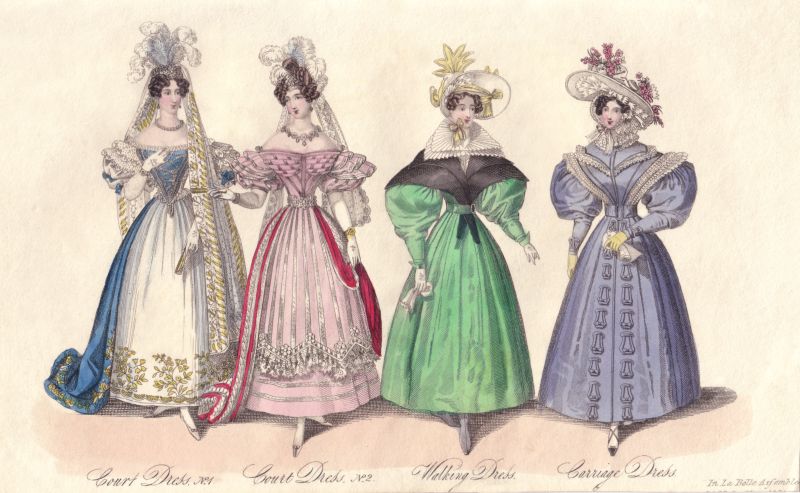
Prices vary and are dependant on the quality and rare value of the print. Here above and below I show two examples of fashion plate engravings bought from eBay in March 2005, through a respected UK seller known as Cabrio4. They cost me £15 for the two.
Of course, if many others had been bidding that day, my purchase may have cost me much much more or I may have abandoned buying the prints altogether. However, these were both very fine purchases and are in a timeframe worth collecting. The detail is exquisite. On other occasions, I've paid much less or much more for a print.
One word of warning with bidding for these at eBay - don't get too carried away until you know what you are bidding on. Fashion plates can be like buses.
You don't see many for a week or two and then just like buses dozens appear.
My advice is that to begin collecting you just watch eBay sales of these for a few weeks if you are interested in starting a collection. Then use your knowledge to gauge the going rate noting the differences between types of plate and the variety available.
This pursuit can be an interesting and related alternative to collecting vintage clothing. It may be used as well, to enhance a clothing collection by helping you become more knowledgeable about style differences in fashionable dress.
I will be adding some more of Cabrio4's plates to the site in due course.
If you want to learn more about fashion and costume plates please visit my new section on this topic in due course where more historical periodical naming information can be dealt with more fully.
The English Approach to Fashion Plates
Mid C19th - Godey's, Peterson's & Graham's Fashion in Magazines
London publishers often copied engraved plates and much was lost in the copying. Although the two most important English magazines of the mid C19th were the Ladies Cabinet and The Ladies' Gazette of Fashions, these English plates are poorly drawn and tinted. Fashion plates from these 2 latter publications are not thought to add to a collection.
The English magazine the Lady's Magazine, knew when it could not match the artistry and simply began importing fashion plates from Le Follet. Much the same happened in America. Later by the 1850s engraved French plates were actually imported to America for Godey's magazine having previously been published in Paris up to eleven months earlier.
C19th American Fashion Magazines
Although as many as 500 periodicals were published in the United States in the early 1800s the few that spring to mind that addressed women and fashion were the outstanding Godey's Lady's Book and Graham's Magazine. By 1842, Graham’s claimed a circulation of 40,000.
Godey's was directed solely at women although men of course read it, whereas Graham's was directed at gentlemen too. Another later magazine was Peterson’s which was initially liked for the fashion plates and early editions had little in the way of depth of articles.
Godey's, Peterson's and Graham's, satisfied a desire for those who were socially mobile to become aware of refined taste in manners, art and literary elements without too much effort. It pandered to the insecurities of an emerging class coming together from many nations and merging as one in a new American society.
It gave tolerable boundary guidelines with hazy references to acceptable and unacceptable behaviors. Such magazines offer us an insight about the daily minutiae of acceptable and unacceptable activities among the emerging middle classes of America.
Panoramic Fashion Plate - Peterson's 1873
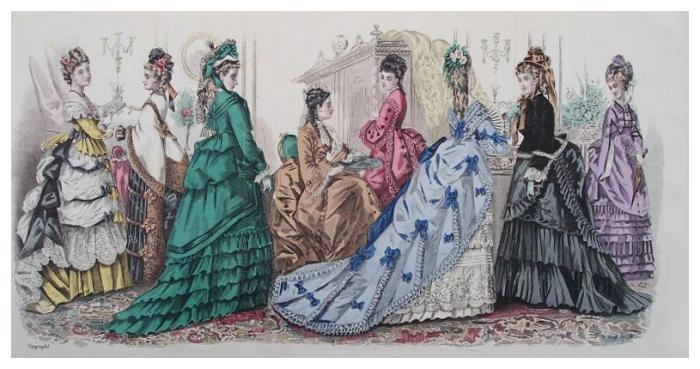
Graham's American Monthly Magazine of Literature, Art and Fashion included fashion, but was directed at both men and women. It contained articles and set pieces by well-known writers such as Edgar Allan Poe.
Godey's Lady's Book was one of the most influential C19th monthly magazines and it became an arbiter of taste manners and etiquette for the epoch. For 30 years Godey’s Lady’s Book was thought an institution and a leading authority on fashion. Yet after the Civil War more fashionable women preferred the periodicals Graham’s and Peterson’s
Peterson's Ladies' Magazine was first published in 1842.
By the 1860s, Peterson's Ladies' Magazine had 150,000 subscribers. Godey's had been sold as a subscription gift that men would buy for wives and sisters and so too was the later Petersons. Peterson's cultivated the idea of middle-class domesticity with articles and by focusing on fiction written mainly by women.
Godey's Ladies' Handbook (American)
The most famous of mid C19th American magazines of this time frame, included Godey's Ladies' Handbook published from July 1830 without break until 1898. We know it today mostly as Godey's Lady's Book, but it had a variety of captions including:-
Fashion Plate - Godey's 1874
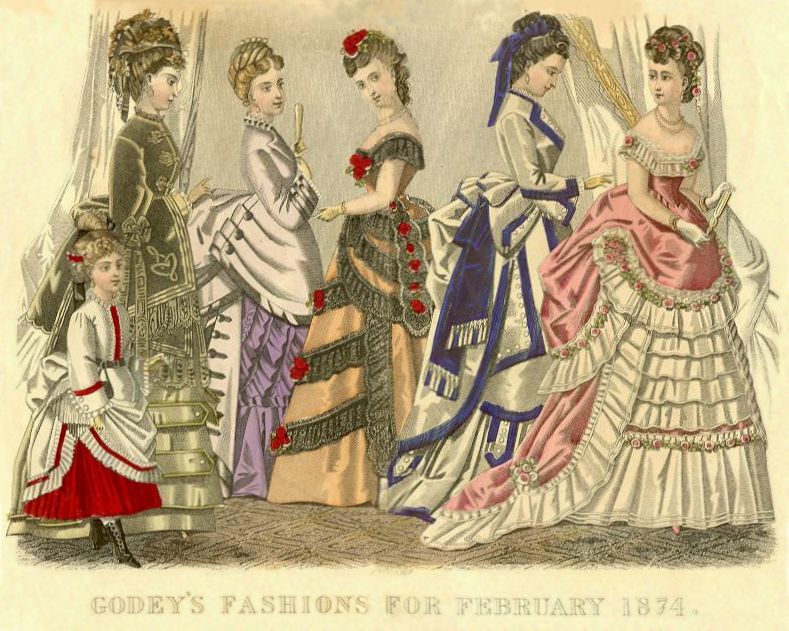
Godey's Lady's Book was published in Philadelphia in the C19th by Mr. Louis A. Godey. Publishing history was made when he employed widow Mrs. Sarah Hale to edit the magazine. Mrs. Sarah Hale continued to do this until 1877. A forthright opinionated, strong, campaigning woman she believed women could achieve any goals she wanted. This was reflected in her editorial style and the inclusion in Godey's Lady's Book with comparatively superwoman style articles with a C19th slant. Against her judgement it included fashion.
There were fashion plates, fashion articles, stories, poems, how to make various crochet, tatting, lace making, knitting, embroidery and other craft articles, recipes and house keeping hints and tips. If you needed to make a pair of dainty slippers, Godey's was the magazine to find such advice!
At the time of the Civil War etiquette advice was very welcome, especially on births marriages and deaths. But apart from that, Godey's paid little or no attention to matters of politics and carried on as before. Edgar Allen Poe, Nathaniel Hawthorn and Henry Wadsworth Longfellow all wrote articles that were published in Godeys.
The fashions were extravagant and generally intended literally for those who were leisurely ladies. This was not a magazine for pioneering women on distant farms and lucky to have one new calico dress a year, but for ladies who aspired to wearing Paris fashions. With any luck the latter may well have already seen all the major cities of Europe and were therefore well able to identify with the opulence of full skirted trailing gowns. New money meant new gowns!
The Civil War interrupted distribution of the magazine and there is a famous line in 'Gone With The Wind' when Scarlett O' Hara despairs for lack of a copy of the latest Godey magazine. The Civil War disrupted distribution of all mail and letters including printed matter. So copies were loaned and passed on to friends and family, which makes them often scarce or in poorer condition than some other magazines of the era.
As so often happened in English and other European publications, many early Godey plates were crude copies from French magazines. Even so the colouring was done by hand, but the quality of the earlier engravings were poorer.
Later by the 1850s engraved French plates were actually imported to America for Godey's magazine. The original engraved plates would have been previously published in Paris up to eleven months earlier.
By 1861 Godey's had 150,000 regular readers and some 150 women hand colour tinted the plates with watercolors. There was no consistency with the coloring of plates and it seems a colorist would use an alternative paint color when the first color ran out. For this reason Godey's pull out prints have the same engraving but can have different colored gowns as many different painters were employed to color them and many used full artistic licences to get their quota completed.
You can collect original Godey prints here, but do be aware that many prints are reproductions.
